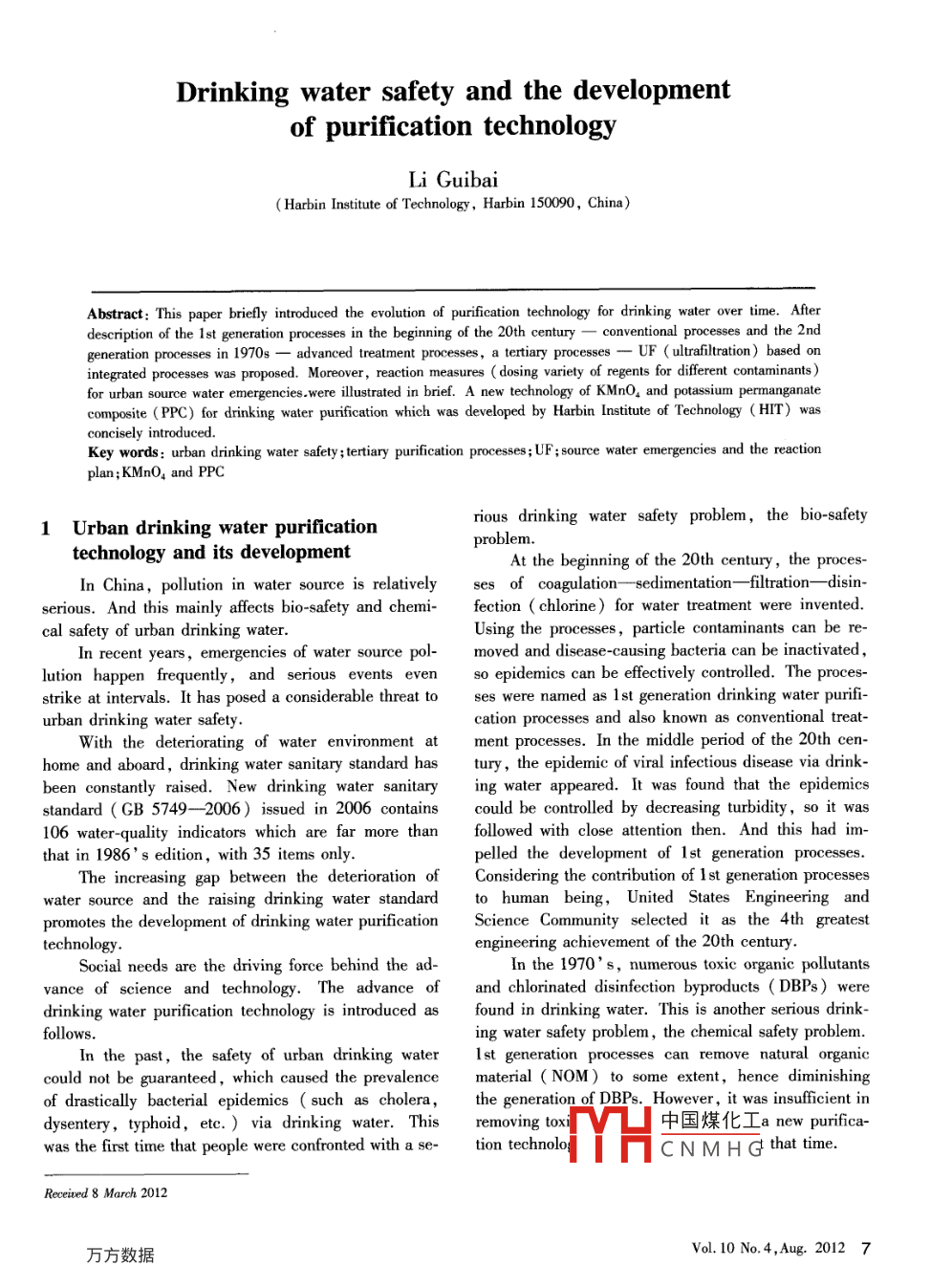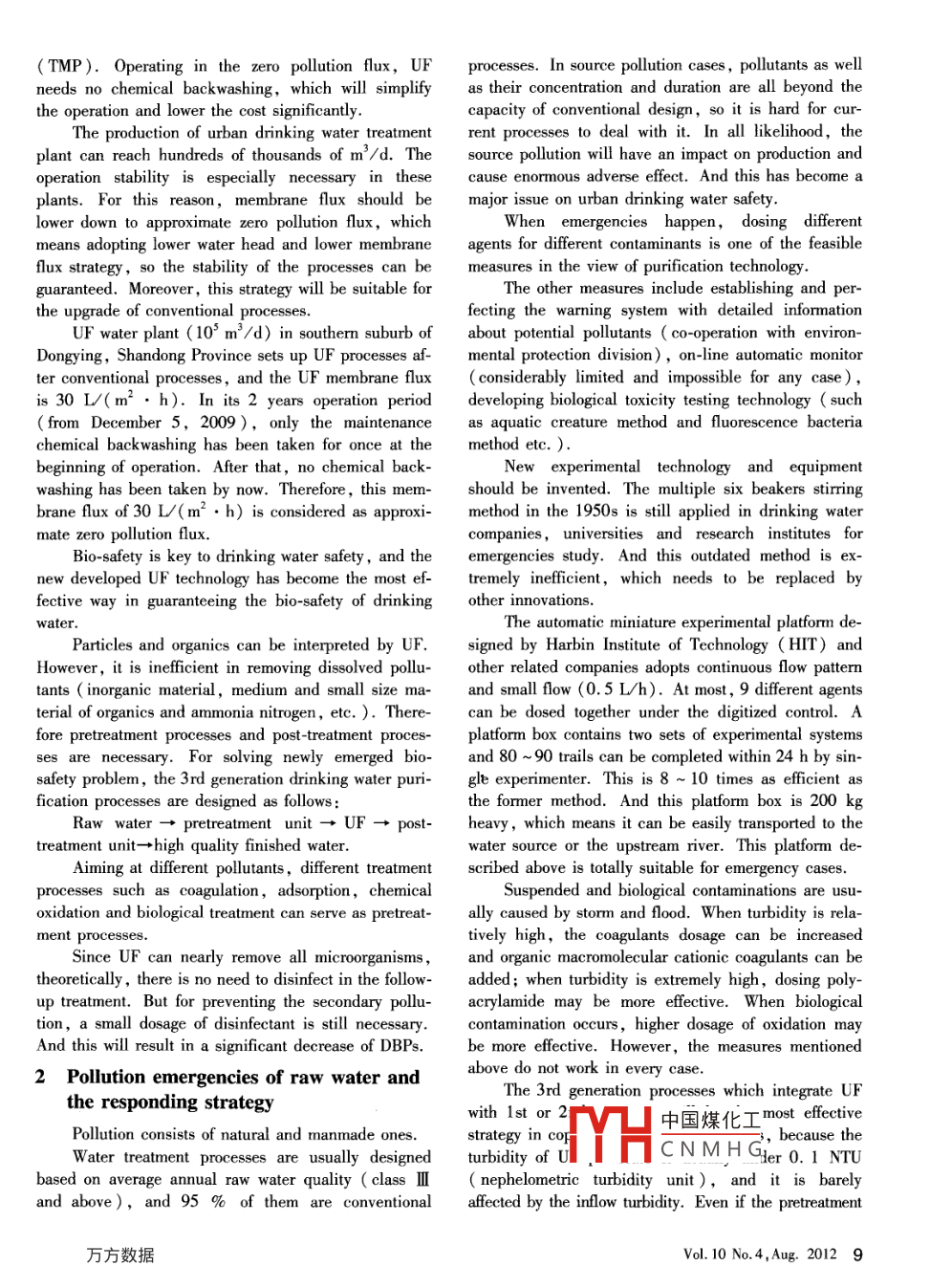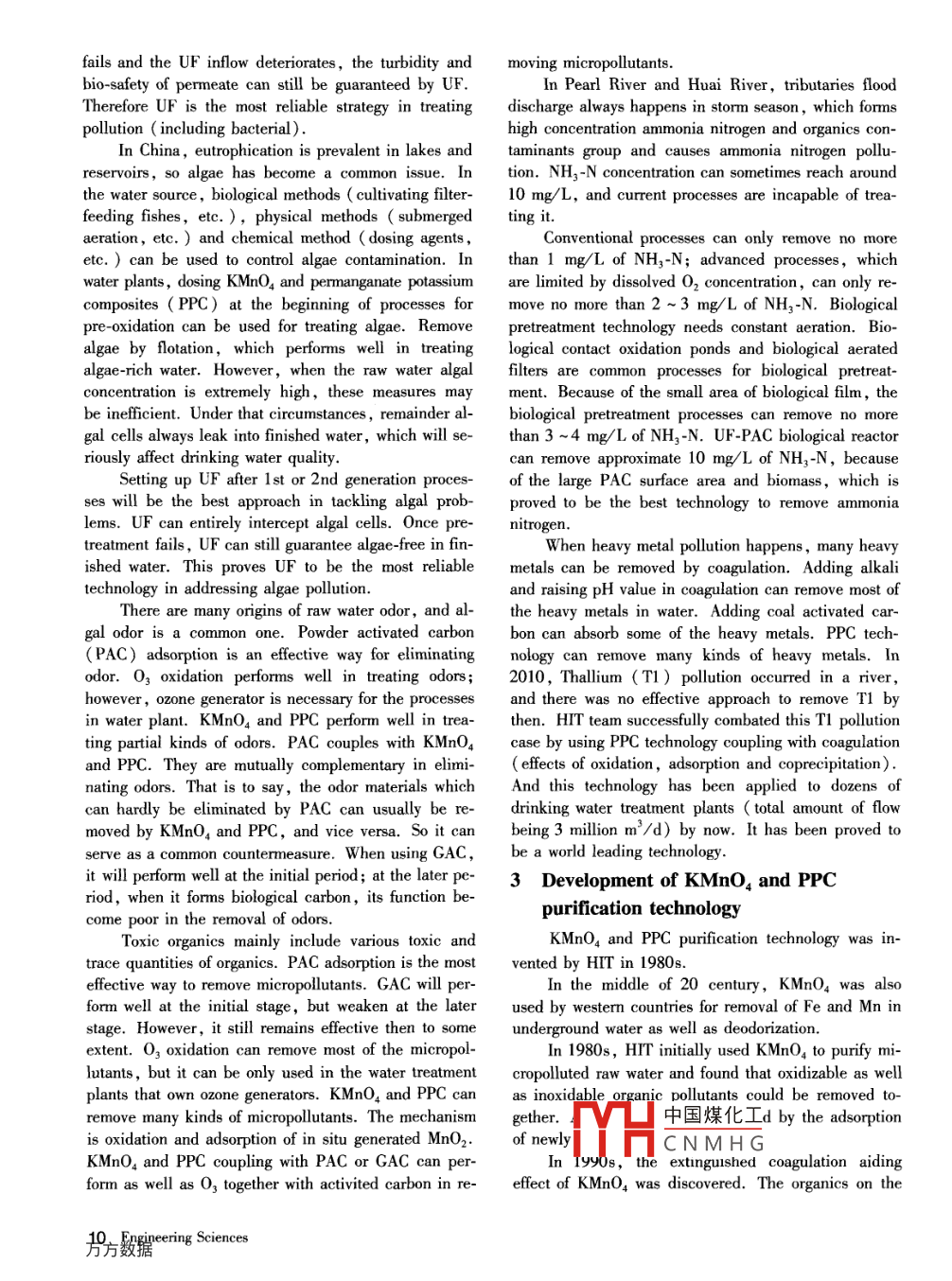

drinking water safety and the development of purification technology免费下载-米乐app官方
- 期刊名字:中国工程科学:英文版
- 文件大小:877kb
- 论文作者:li guibai
- 作者单位:(harbin institute of technology
- 更新时间:2020-07-08
- 下载次数:次
drinking water safety and the developmentof purification technologyli guibai( harbin institute of technology,harbin 150090, china)abstract: this paper briely introduced the evolution of purification technology for drinking water over time. afterdescription of the 1st generation processes in the beginning of the 20th centuryconventional processes and the 2ndgeneration processes in 1970sintegrated processes was proposed. moreover ,reaction measures ( dosing variety of regents for different contaminants)for urban source water emergencies.were ilustrated in brief. a new technology of kmno, and potassium permanganatecomposite (ppc) for drinking water purification which was developed by harbin institute of technology (ht) wasconcisely introduced.key words: urban drinking water safety ;tertiary purifcation processes; uf ;source water emergencies and the reactionplan;kmno4 and ppcrious drinking water safety problem, the bio-safetylurban drinking water purificationproblem.technology and its developmentat the beginning of the 20th century, the proces-in china,pollution in water source is relativelysef coagulation- -sedimentation- -filtration- -disin-serious. and this mainly affects bio-safety and chemi-fection ( chlorine ) for water treatment were invented.cal safety of urban drinking water.using the processes,particle contaminants can be rein recent years,emergencies of water source pol-moved and disease-causing bacteria can be inactivated,lutionhappen frequently, and serious events evenso epidemics can be efectively controlled. the proces-strike at intervals. it has posed a considerable threat toses were named as 1st generation drinking water purifi-urban drinking water safety.cation processes and also known as conventional treat-with the deteriorating of water environment atment processes. in the middle period of the 20th cen-home and aboard,drinking water sanitary standard hastury, the epidemic of viral infectious disease via drink-been constantly raised. new drinking water sanitarying water appeared. it was found that the epidemicsstandard ( gb 5749- 2006) issued in 2006 containscould be controlled by decreasing turbidity, so it was106 water-quality indicators which are far more thanfollowed with close attention then. and this had im-that in 1986 ' s edition, with 35 items only.pelled the development of 1st generation processes.the increasing gap between the deterioration oconsidering the contribution of 1 st generation processeswater source and the raising drinking water standardo human being, united states engineering andpromotes the development of drinking water purificationscience community selected it as the 4th greatesttechnology.engineering achievement of the 20th century.social needs are the driving force behind the ad-in the 1970' s, numerous toxic organic pollutantsvance of science and technology. the advance ofand chlorinated disinfection byproducts ( dbps) weredrinking water purification technology is introduced asfound in drinking water. this is another serious drink-follows.ing water safety problem, the chemical safety problem.in the past, the safety of urban drinking waterst generation processes can remove natural organiccould not be guaranteed,which caused the prevalencematerial ( nom) to some extent, hence diminishingof drastically bacterial epidemics ( such as cholera ,the generation of dbps. however, it was insufficient indysentery,typhoid, etc. ) via drinking water. thisremoving to)中国煤化工a new purifica-was the first time that people were confronted with a se-tion technolomcnmhgthattime.receited 8 march 2012vol. 10 no. 4,aug.2012 7it is found that 03 oxidation and activated carbonlows: virus being 20 ~ several hundred nm,bacteriumadsorption perform well in treating toxic micropolluta-being several hundred nm ~ several μum, protozan be-nts. the 1 st generation processes coupling with o3-ing several μm ~ umpty μm,algae being severalgac ( granular activated carbon) have the advantageμum ~ several hundred μm.of removing toxic micropollutants ,thus controlling thethe pore size of microfiltration ( mf) is 100 ~dbps. the processes are referred as advanced treat-200 nm which is not small enough to intercept bacteriamenor 2nd generation processes. 2nd generationand virus. the pore size of nanofiltration( nf) isprocesses have been commonly used aboard, while it is1 nm or so,and this size of ultrafiltration ( uf) isgradually applied at home.several nm. both of them can almost remove all the mi-at the end of the 20th century, the major drinkingcroorganisms in water, so they are considered as thewater safety problem which was represented by giardia-best method for enhancing bio-safety. it is suggestedsis and cryptosporidium appeared. this was consideredthat the pore size of uf membrane used for drinkingas new bio-safety problem.water treatment should not be bigger than 20 nm. nfgiardiasis and cryptosporidium are pathogenicmembrane is expensive and high energy-consuming,protozoa with wide distribution in nature, and they canwhile the price of uf membrane has been reduced toparasitize in animals or human. the cyst cell of giar-an acceptable level, so that uf has become the mostdiasisisovate,8~12μminlength,7~10μminsuitable processes for large-scale urban water treatmentwidth; the oocyst of cryptosporidium is globular inlant.shape, 4 ~6 μm in length.uf processes can almost remove all the microor-the aforementioned cyst or oocyst cells will con-ganisms in water, which will surely enhance bio-safetytaminate the raw water through the excretion of ani-of drinking water. and this will bring about a greatmals. when water treatment processes fail, the cellsrevolution for drinking water purification processes.can penetrate through the filter bed. with strong chlo-the application of uf in drinking water plant canrine resistance,the cyst has drastic pathogenicity asreplace 1 st generation processes:well. this disease happened frequentlyaround theraw water-→uf-→disinfection- finished water.world. in 1993,cryptosporidium disease burst in mil-for high turbidity raw water, uf can be set afterwaukee, america, and around 400 000 cases of illness1st generation processes:had been confirmed.raw water →coagulation - sedimentation - filtra-algae crisis includes blue-green algae and greention-→∪f→disinfection-→finished water.algae bloom, which can cause serious impact onfor micropolluted raw water, pac or kmno, andaquatic ecosystem; some algae can produce toxins ;ppc can be dosed :some of them produce stink.pacdetrimental aquatic creatures problem is mainlyraw water十coagulation -→sedimenta-cyclops and blood wormns bloom. cyclops is the host ofkmno, and ppcpathogenic dracunculiasis.another is the bio-stabilty problem. the standardtion- filtration- uf- disinfection-→finished water.finished water may experience microorganism bloom inuf can be set after 2nd generation processes:distribution and storage, which indicates it is not bio-raw water -→coagulation→sedimentation→filtra-stable. in safe drinking water, the total amount of bac-tion-→o3→gac- uf- disinfection- finished water.teria is requested less than 100 cfu ( colony-formingtechnical and economic flexibility is necessary inunit) per 1 l; however, this is relatively safe only.all engineering projects. membrane flux relates to thethe more the microorganisms in the water, the less theconstruction cost as wel as operation and maintenancesafety.cost. the higher membrane flux is, the less construc-in the 2nd generation processes, a great deal oftion cost is, the more operation cost is, includingmicroorganisms grow in the cac bed, and the amountenergy charge, physical backwashing and chemicalof bacteria in the effluent increases significantly. thebackwashing,and vice versa. in the whole refund2nd generation processes improve the chemical safetyperiod, the membrane flux which makes the construc-of drinking water, while impair the bio safety.on cos中国煤化工clled economicelthe 1st and 2nd generation processes can hardlymembrasolve bio-safety problem, so that the new generationzeryhc n m h gbrane flux in whichprocesses are necessary.membrane module can stably operate for a long termthe sizes of pathogenie microorganism are as fol-without the increase of trans- membrane pressure号片数糖ering sciences( tmp). operating in the zero pollution flux, ufprocesses. in source pollution cases, pollutants as wellneeds no chemical backwashing, which will simplifyas their concentration and duration are all beyond thethe operation and lower the cost significantly.capacity of conventional design, so it is hard for cur-the production of urban drinking water treatmentent processes to deal with it. in all likelihood, theplant can reach hundreds of thousands of m'/d. thesource pollution will have an impact on production andoperation stability is especially necessary in thesecause enormous adverse effect. and this has become aplants. for this reason, membrane flux should bemajor issue on urban drinking water safety.lower down to approximate zero pollution flux, whichwhen emergencies happen, dosing differentmeans adopting lower water head and lower membraneagents for different contaminants is one of the feasibleflux strategy, so the stability of the processes can bemeasures in the view of purification technology.guaranteed. moreover , this strategy will be suitable forthe other measures include establishing and per-the upgrade of conventional processes.fecting the warning system with detailed infornationuf water plant (10* m'/d) in southern suburb ofabout potential pollutants ( co-operation with environ-dongying,shandong province sets up uf processes af-mental protection division) ,on-line automatic monitorter conventional processes, and the uf membrane flux( considerably limited and impossible for any case) ,is 30 l(m2. h). in its 2 years operation perioddeveloping biological toxicity testing technology ( such( from december 5,2009 ),only the maintenanceas aquatic creature method and fluorescence bacteriachemical backwashing has been taken for once at themethod etc. ).beginning of operation. after that ,no chemical back-new experimental technology and equipmentwashing has been taken by now. therefore, this mem-should be invented. the multiple six beakers stirringbrane flux of 30 l(m2●h) is considered as approxi-method in the 1950s is still applied in drinking watermate zero pollution flux.companies,universities and research institutes forbio-safety is key to drinking water safety, and theemergencies study. and this outdated method is ex-new developed uf technology has become the most ef-tremely ineffcient, which needs to be replaced byfective way in guaranteeing the bio-safety of drinkingother innovations.water.the automatic miniature experimental platform de-particles and organics can be interpreted by uf.signed by harbin institute of technology (hit) andhowever, it is inefficient in removing dissolved pollu-other related companies adopts continuous flow patterniants ( inorganic material, medium and small size maand small flow (0.5 l/h). at most, 9 different agentsterial of organics and ammonia nitrogen, etc. ). there-can be dosed together under the digitized control. afore pretreatment processes and post-treatment proces-platform box contains two sets of experimental systemsses are necessary. for solving newly emerged bio-and 80 ~ 90 trails can be completed within 24 h by sin-safety problem, the 3rd generation drinking water puri-gle experimenter. this is 8 ~ 10 times as efficient asfication processes are designed as follows:the former method. and this platform box is 200 kgraw water →pretreatment unit - uf - - post-heavy, which means it can be easily transported to thetreatment unit- →high quality finished water.water source or the upstream river. this platform de-aiming at different pollutants , different treatmentscribed above is totally suitable for emergency cases.processes such as coagulation, adsorption, chemicalsuspended and biological contarminations are usu-oxidation and biological treatment can serve as pretreat-ally caused by storm and flood. when turbidity is rela-ment processes.tively high,the coagulants dosage can be increasedsince uf can nearly remove all microorganisms,and organic macromolecular cationic coagulants can betheoretically, there is no need to disinfect in the follow-added ; when turbidity is extremely high, dosing poly-up treatment. but for preventing the secondary pollu-acrylamide may be more effective. when biologicaltion, a small dosage of disinfectant is still necessary.contamination occurs, higher dosage of oxidation mayand this will result in a significant decrease of dbps.be more effective. however, the measures mentioned2 pollution emergencies of raw water andabove do not work in every case.the 3rd generation processes which integrate ufthe responding strategywith 1st or中国煤化工r most effectivepollution consists of natural and manmade ones.strategy in comyhcnmhgier0.1 ntubecause thewater treatment processes are usually designedturbidity ofbased on average annual raw water quality ( class ii( nephelometric turbidity unit ),and it is barelyand above), and 95 % of them are conventionalaffected by the inflow turbidity. even if the pretreatmentvol. 10 no.4,aug. 2012 9fails and the uf inflow deteriorates, the turbidity andmoving micropollutants.bio-safety of permeate can still be guaranteed by uf.in pearl river and huai river, tributaries floodtherefore uf is the most reliable strategy in treatingdischarge always happens in storm season , which formspollution ( including bacterial).high concentration ammonia nitrogen and organics con-in china, eutrophication is prevalent in lakes andtaminants group and causes ammonia nitrogen pollu-reservoirs, so algae has become a common issue. intion. nhz-n concentration can sormetimes reach aroundthe water source, biological methods ( cultivating filter-10 mg/l, and current processes are incapable of trea-feeding fishes, etc. ),physical methods ( submergedting it. .aeration, etc. ) and chemical method ( dosing agents,conventional processes can only remove no moreetc. ) can be used to control algae contamination. inthan 1 mg/l of nh3-n; advanced processes ,whichwater plants, dosing kmno4 and permanganate potassiumure limited by dissolved 02 concentration, can only re-composites ( ppc) at the beginning of processes formove no more than 2 ~ 3 mg/l of nh3-n. biologicalpre-oxidation can be used for treating algae. removepretreatment technology needs constant aeration. bio-algae by flotation, which performs well in treatinglogical contact oxidation ponds and biological aeratedalgae-rich water. however, when the raw water algalfilters are common processes for biological pretreat-concentration is extremely high, these measures maynent. because of the small area of biological film, thebe inefficient. under that circumstances , remainder al-biological pretreatment processes can remove no moregal cells always leak into finished water, which will se-than 3 ~4 mg/l of nh3-n. uf-pac biological reactorriously affect drinking water quality.can remove approximate 10 mg/l of nh3-n, becausesetting up uf after 1st or 2nd generation proces-of the large pac surface area and biomass, which isses will be the best approach in tackling algal prob-proved to be the best technology to remove ammonialems. uf can entirely intercept algal cells. once pre-nitrogen.treatment fails, uf can still guarantee algae-free in fin-when heavy metal pollution happens , many heavyished water. this proves uf to be the most reliablemetals can be removed by coagulation. adding alkalitechnology in addressing algae pollution.and raising ph value in coagulation can remove most ofthere are many origins of raw water odor, and al-the heavy metals in water. adding coal activated car-gal odor is a common one. powder activated carbonbon can absorb some of the heavy metals. ppc tech-( pac) adsorption is an effective way for eliminatingnology can remove many kinds of heavy metals. inodor. o3 oxidation performs well in treating odors;2010, talium (t1) pollution occurred in a river,however, ozone generator is necessary for the processesand there was no effective approach to remove t1 byin water plant. kmno4 and ppc perform well in trea-then. hit team successfully combated this t1 pollutionting partial kinds of odors. pac couples with kmno4case by using ppc technology coupling with coagulationand ppc. they are mutually complementary in elimi-( effects of oxidation,adsorption and coprecipitation).nating odors. that is to say, the odor materials whichand this technology has been applied to dozens ofcan hardly be eliminated by pac can usually be re-drinking water treatment plants ( total amount of flowmoved by kmno。and ppc, and vice versa. so it canbeing 3 million m'/d) by now. it has been proved toserve as a common countermeasure. when using gac,be a world leading technology.it will perform well at the initial period; at the later pe-3 development of kmno, and ppcriod, when it forms biological carbon, its function be-purification technologycome poor in the removal of odors.toxic organics mainly include various toxic andkmno。and ppc purification technology was in-trace quantities of organics. pac adsorption is the mostvented by hit in 1980s.effective way to remove micropollutants. gac will per-in the middle of 20 century, kmno4 was alsoform well at the initial stage, but weaken at the laterused by westerm countries for removal of fe and mn instage. however, it still remains effective then to someunderground water as well as deodorization.extent. o3 oxidation can remove most of the micropol-in 1980s, hit initially used kmno。to purify mi-lutants, but it can be only used in the water treatmentcropolluted raw water and found that oxidizable as wellplants that own ozone generators. kmno4 and ppc canas inoxidable. organic pollutants could be removed to-remove many kinds of micropollutants. the mechanismgether.中国煤化工d by the adsorptionis oxidation and adsorption of in situ generated mno2.of newlyhcnmhgkmno4 and ppc coupling with pac or gac can per-in 1990s, the extingulshed coagulation aidingform as welll as o3 together with activited carbon in re-effect of kmno4 was discovered. the organics on the放r感eenig scienescolloidal surface can be oxidized by kmno and newlyadvanced oxidation has never been reported abroad upgenerated mno2 can serve as the core of floc, thus en-to now.hancing coagulation.the oxidation byproducts of ppc have been stud-in the end of 20 century, ppc was invented. theed. kmno4 has been applied for more than 60 yearsauxiliary agents can assist kmno, in purification.( since the middle of 20 century ). neither foreigntechnology of removing contamination and deodo-studies, nor 30 years of domestic lab tests, pilot stud-rization by integrating ppc with pac was developed.ies and engineering applications have reported the toxictechnology of removing pollution by coupling ppcbyproducts of kmno。. so that it is considered as thewith gac has been developed, and it is as effective assafest oxidant so far, and it is also called green oxidanto3 -actived carbon.abroad.technology of o3 catalytic oxidation and advancedbecause of the safety of kmno4,the study andoxidation has been developed. the micro interface ofapplication of kmno4 has been prevalent abroad, suchtranstion metals (fe, mn) is used to generate radicalsas removing endocrine disrupters ( eds). .which can oxidize and remove highly stable organics.kmno, and ppc purification technology is expec-this technology has been applied to a dozen of waterted to be a highly promising inovation for the futureplants in china. however, the full-scale application ofdevelopment and application.authorli guibai, male, was bormn in yanshi of henan province in 1933. he is a mumber of chinese academy ofengineering and mainly engaged in the research on membrane purification technology , especially for drinking watertreatment , and manganese and iron removal in water supply technology. he has published over 100 papers and3 monographs.(cont. from p.6)5 conclusiontechniques are to be developed to solve problems inthis field. and the development of china' s engineer-at present, with rapid development of construc-ing technology will contribute to the international sci-tion engineering,large-span underground projects be-ence and technology community.come increasingly popular and important. more newzhou fengjun, male, born in 1938, graduated from tsinghua university. he is a member of chinese academyof engineering and a researcher of beiing canbao architecture design institute, bejjing, china. mr. zhou haspublished over 20 papers. his curent research is the field of public safety of subway and large -span undergroundengineering. he can be reached by e-mail: zhouf@ cae. cn .中国煤化工myhcnmhgvol. 10 no. 4,aug.2012 11
-
c4烯烃制丙烯催化剂 2020-07-08
-
煤基聚乙醇酸技术进展 2020-07-08
-
生物质能的应用工程 2020-07-08
-
我国甲醇工业现状 2020-07-08
-
jb/t 11699-2013 高处作业吊篮安装、拆卸、使用技术规程 2020-07-08
-
石油化工设备腐蚀与防护参考书十本免费下载,绝版珍藏 2020-07-08
-
四喷嘴水煤浆气化炉工业应用情况简介 2020-07-08
-
lurgi和ici低压甲醇合成工艺比较 2020-07-08
-
甲醇制芳烃研究进展 2020-07-08
-
精甲醇及mto级甲醇精馏工艺技术进展 2020-07-08


